Week 3: motor control and learning
1/40
There's no tags or description
Looks like no tags are added yet.
Name | Mastery | Learn | Test | Matching | Spaced |
|---|
No study sessions yet.
41 Terms
Application of motor control & learning to OT
Think about all the activities one participates in…and the movements associated with any activity
E.g. sitting, standing, walking, reaching, balance, timing, sequencing, force productions etc. etc.
What about all the factors that influence movement?
Muscle tone (Hyper- vs. Hypotonicity); ROM (limited ROM); Muscle strength & endurance (be able to move against gravity, maintain posture against gravity); Sensory processing abilities (sense change in movt. or position); Cognition (attention, problem-solving, etc.); Environmental factors (contexts in which movement occurs); Task factors (properties of the object, motivating, etc.)
As OTs we are interested in helping our clients participate in all activities
OTs use principles of motor control & learning to help address motor control deficits
Motor Control
Refers to how the body processes, organizes and directs movements
The neuromuscular processes that lead to movement. i.e. how do humans control their muscles & joints to produce an action (Physiological aspect)
The behaviors that promote the movement skill. i.e. what does a human do to gain skills? (Psychological aspect)
Motor Learning and OT
Refers to the strategies & techniques used to teach movement
It’s the process, circumstances & amount in which a person learns motor skills
OTs look at evidence-based strategies & techniques that help children to learn & retain movements in order to participate in various activities
motor control looks at
How does the musculoskeletal system interact to produce movements?
How does the CNS organize movements?
How do we quantify the nature of movement? (quality & timing of movement)
What is the sequence of motor development?
What factors influence movement?
What explains the variance in movement?
Dynamic Systems Theory
Motor control is dependent on person, task & env. factors
Ecological Theory
Emphasizes the interaction between person, task & env. factors
Principles of Motor Control
•1. Movement is a result of interaction among systems (person, occupation, environment) and this interaction is essential to adaptive control of movt.
•2. Lack of adaptability in movt. patterns to accommodate task demands & environmental constraints leads to motor dysfunction
•3. Task modifications & adaptations may change the child’s ability to engage in desired occupations
•4. Engagement in meaningful activities within a supportive environment is important to facilitate learning and retaining of movements
Interaction among systems
Movement is a result of interaction among systems (person, occupation, environment) and this interaction is essential to adaptive control of movement
OT consideration: OTs need to assess & consider the influence of multiple systems when designing interventions
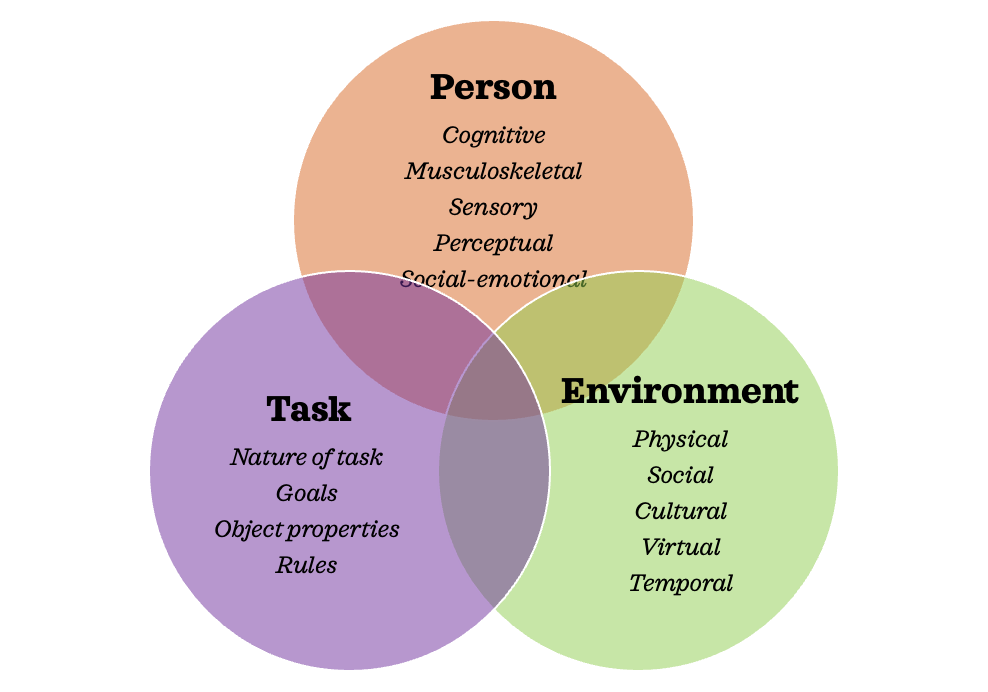
. Adaptability & Environmental Constraints
◦Variability is an important factor in learning efficient movement
◦Typically developing children move in a variety of ways
◦They problem-solve & show variability in their movements to address any challenge (e.g. Hudson)
◦Children with motor control challenges often lack variety in movement & the ability to adapt their movements to accommodate task demands
◦They typically move in the same pattern & often demo. difficulty with movements in new environment or when participating in novel task
◦Environmental constraints such as barriers in physical env. could be a factor that leads to motor dysfunction
OT consideration: OTs should consider helping clients develop a variety of movements that they can use across a variety of contexts
Task modifications & adaptations
Degrees of freedom: possible planes of motion in the joints controlled by musculoskeletal & CNS = Difficulty in planning & executing movt. may be changed by altering the degrees of freedom required to accomplish a movement
e.g., Calvin wearing his pants in sitting then leaning against the wall (corner)
Attractor State: tendency to stay in patterns of preferred state or a state requiring fewest degrees of freedom = Identify attractor state, and if it limits function, facilitate movement away from this state (aka perturbation) to promote engagement in occupation
e.g., Hudson preferring to side sit & scoot due to weaker L side
OT consideration: Task modifications or adaptations can change the child’s ability to participate in different occupations
Engagement in meaningful activities
•When engaged in meaningful activities (important & fun)
•Motivated to engage in difficult motor skills
•Stay engaged for longer periods of time
•Quality of movement improves
OT consideration: Observe & understand what is meaningful to the client
(PVQ, COSA)
Motor Learning (def)
Process in which a relatively permanent change occurs in motor skills of a child through practice & experience which can then be transferred to new learning situations
Motor Learning is about…
How do people learn movement?
What is the most effective teaching strategy?
When should one provide feedback/cues?
What strategies help people learn movements?
Three stages of Motor Learning
cognitive
associative
autonomous
Cognitive
•Skill acquisition of new knowledge
•Child practices new movts, errors are common & movts. may be inefficient
•Learners need frequent repetition & feedback (learning to use a utensil)
•“What is it that must be done?”
•Associative
•This stage involves skill refinement, less errors & increased consistency & efficiency
•Learner associates past experiences to present, thereby associating movements
•“How to do?”
•Autonomous
•Learner retains the skills , skills are refined or tuned
•Skills are transferred easily across task & environments
•At this stage motor skills have been learned & need less attention (e.g. feed self & talk)
•“How to succeed?”
Motor Skill Acquisition
OT plays an important role in helping clients demonstrate consistency, flexibility & efficiency in movements
Consistency: Ability of the child to perform a task consistently over time
Flexibility: Ability to adapt & modify task performance based on env. & context
Efficiency: Pertains to endurance-cardiovascular & musculoskeletal system
Cognitive phase -> Autonomous phase
Lower consistency, flexibility & efficiency -> Higher consistency, flexibility & efficiency
Things to consider when teaching Motor Learning strategies
As an OT think about the following as you plan intervention using Motor Learning strategies:
How will you facilitate practice?
What will you as the OT do during practice?
What will you as an OT say during practice?
Motor Learning strategies
(categories)
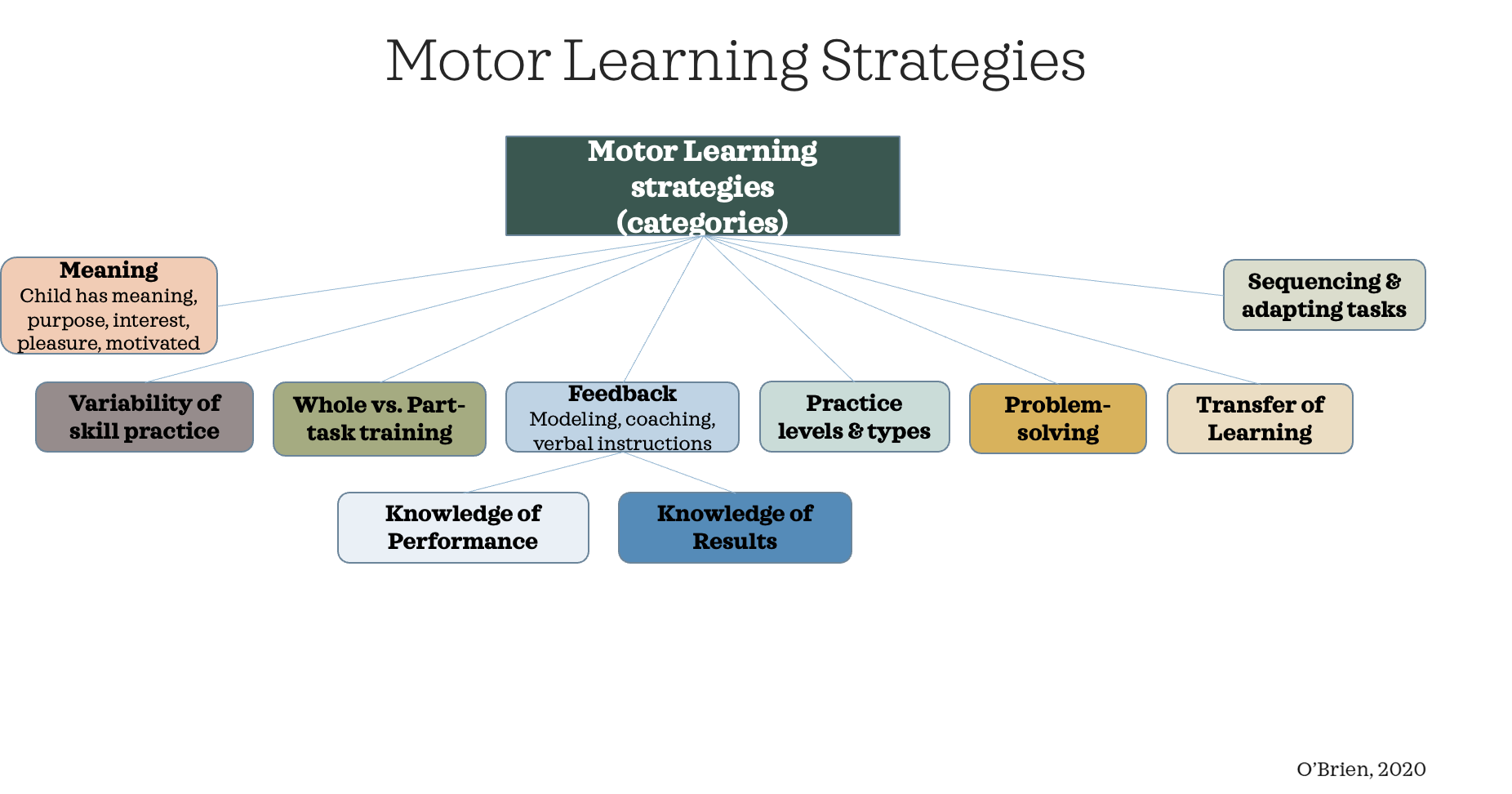
Variability of Practice
Movement occurs in a variety of contexts
Variation in task parameters (e.g. speed, force, accuracy, distance, & timing)
Variation in object properties
In some cases, if variability is “too much” & it impacts function, then minimize by establishing consistency (e.g. children with CP)
OT consideration: OTs should consider helping clients develop a variety of movements that they can use across a variety of contexts; OTs should identify & support optimal level of variability
Research Connection: Variability is central to functional movements (Sugden & Dunford, 2007; Thelen, 2000; Thelen et al., 1987)
whole task training
Participating in a whole task (occupation) shown to be more motivating
It facilitates multiple systems & therefore more effective
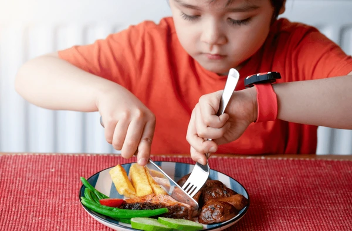
part task training
refers to shaping the child’s ability so they can perform a task
Based on child’s success in initial steps until the entire sequence is learned (Gorden et al., 2011)
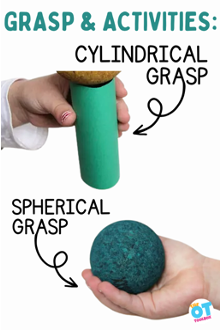
research for Whole- vs. Part-Task Training
shows more brain activation happens when engaged in active whole task (grasp & release of an object during play) as opposed to passive parts of the task (open and close hand/fingers 10x)



Intrinsic feedback
child self-corrects; most effective for maintaining motor performance; should be promoted during therapy (e.g., “I think I am doing a good job.”)
Forms of _ feedback
Feed forward- imagery
Feedback- on results and/or on the performance itself
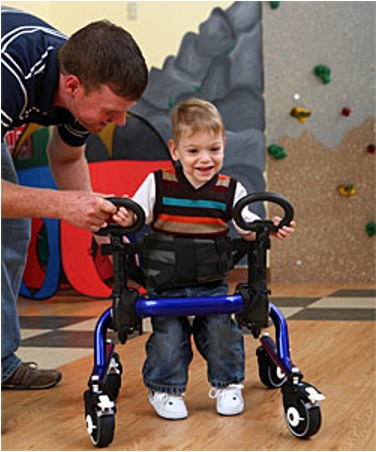
extrinsic feedback
providing verbal or physical assistance; typically used at the beginning stages of learning (e.g., “Good job using the fork to stab the food and bring to your mouth.” )
Forms:
Feed forward- by modeling/demonstration
During the performance: cues, emphasize key aspects, ask reflective questions
Feedback: on results and/or on the performance itself
OT consideration: Remember feedback reinforces learning; provide appropriate feedback (verbal vs. modeling); provide brief (fewer words) feedback; highlight key aspects (not just a general “good job!”); carefully time (immediate vs. at the end)
Research Connection: “Positive feedback results in better motor learning & perceived competence” (Goncalves et al., 2018)
Knowledge of Results (KR)
§Stating specific info. re: the movement’s goal
§Giving feedback re: results at the end of the task
§E.g., “each button is lined up with its buttonhole”
Knowledge of Performance (KP)
•Provide with information about how the child performed movement
•Provide feedback about specific components of movement
•E.g., “I like how you held the pencil between thumb & fingers with just-right pressure during writing task”
Practice levels & types
Practice should involve active problem solving
Frequent & challenging
Variable: practicing variations of the task (e.g. transferring from wheelchair to bed)
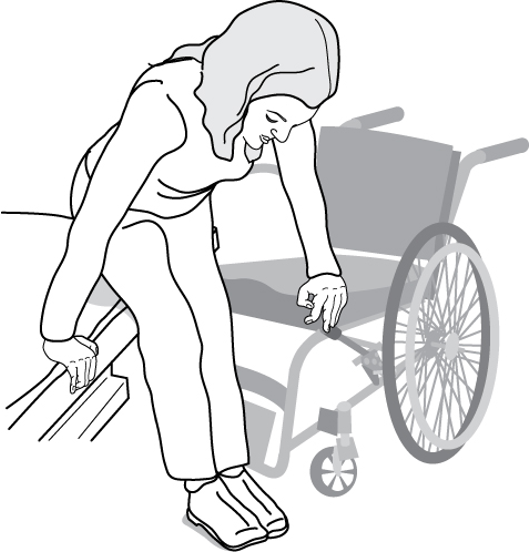
Massed(Blocked) vs. Distributed:
Rest time < Practice time vs. Practice time < Rest time
Massed- useful during cognitive stage of learning vs. Distributed- during associative stage
Variable vs. Constant:
Repeat same patterns with variations or small changes as necessary vs. repeating the same task over & over again (e.g. throwing bean bags with diff. weights)
Variable- beneficial during final stages of motor learning (autonomous stage)
3. Physical vs. Mental Practice
Child has direct experience engaging in an activity vs. performing the skill in one’s imagination
Mental Practice is also referred to as motor imagery
Performing the skill in one’s imagination (e.g. Wyatt)
Found to be most effective during early and later stages of learning and can be very task-specific
Should be combined with physical practice when ever possible (Bovend Eerdt, Dawes, Sackley, & Wade, 2012; Dawson 2017; McEwen & Houldin, 2017)
Physical vs. Mental Practice considerations
OT consideration: When planning intervention sessions, think about what stage is the client at (cognitive, associative, autonomous) when deciding the levels and type of practice
Research Connection: “research demonstrates use of practice to improve or develop motor skills”
Problem Solving or Error-Based Learning
Provide child opportunity to make errors when practicing
The child gets the opportunity to self-correct (reflects on what happened -> What worked/ What did not work?)
Safety is always considered (never put child in an unsafe position or environment)
OT consideration: Facilitate participation in activities that are challenging for the child; provide opportunity to self correct (do not jump in with solution); ask reflective questions as opposed to telling them what to do
Research connection: Children retain motor skills when they problem-solve & self-correct (Bouffard & Wall, 1990; Missiuna et al., 2002; Miyahara et al., 2004; Polotajko et al., 2001)
Transfer of Learning
Provide child opportunity to generalize learning across contexts, environment & tasks
Goal of therapy is for the child to participate in their natural environment in a natural context
Consider characteristics of the environment-
Clinic space vs. simulated environment vs. real environment
OT consideration: Facilitate participation in activities in the “real” or “natural” environment if possible; consider characteristic of the environment (realistic)
Research connection: Transfer of learning occurs better when participating in functional task (occupation)
Scaffolding
one of the strategies used to promote transfer of learning
•Provide support during the initial learning stages, with the idea of gradually removing the support to promote learner’s autonomy
OT steps for transfer of learning
•Facilitate participation in activities that builds on client’s prior knowledge & skills
•Just-Right challenge: Design Tx activities that challenges the client’s current skill (slightly harder )
•Provide assistance & feedback as needed esp. in the early stages
•Gradually fade away assistance until the client no longer requires any support
Sequencing & Adapting task
Discrete task vs. Continuous task
Discrete- task with definite beginning & end
E.g., Jump over the rope 1x
Continuous- task that is ongoing (i.e., series of discrete steps that make it a continuous task)
E.g., Jumping rope for a minute
OTs need to consider the cognitive demands of the task as well (e.g. start with simple motor task with less cognitive demands)
OT consideration: Consider cognitive demands of the activity on the child; start with child participating in whole task (continuous)- if the child demonstrates difficulty with a particular component-consider using discrete task; sequence & adapt activities to promote success
Research connection: Children with certain conditions like CP may have less ability to adapt or vary their movt. patterns depending on the context or the env. they participated in. OTs need to take that into consideration when planning intervention (Russell et al., 200; Tieman et al., 2007).
Tips to consider: cognitive
Use catchy words/pneumonic (e.g. nose before toes)
Facilitate repetition of skills
Provide opportunity to problem-solve
Use simple phrases/statements/ verbal cues
tips to consider: Associative
Be intentional about relating new tasks to past tasks
Use same phrases/statements for similar task
Help connect links to other successful activities
tips to consider: autonomous
Provide opportunity for the child to self-reflect & evaluate
Fade away support & cues as appropriate
Application of Motor Control/Motor Learning in OT practice- Intervention
Assess the child's current stage of learning
Ensure tasks are clear, specific, and aligned with the child's goals
Focus on whole tasks and activities that are meaningful and relevant
Encourage active problem-solving throughout the process
Facilitate ability to respond to environmental challenges
Offer varied practice opportunities to promote skill development
Avoid repetitive, non-engaging tasks (rote practice) that lack motivation for the child